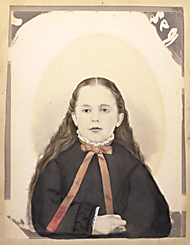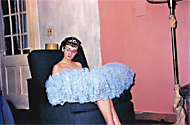
 |
 |
From the series "Family Portraits," about 1848–1855, Hand-colored salted paper print, unknown American photographer
|
 |
 |
|
|
 |
The photograph began to replace the painted portrait in the mid-1800s. This exhibition includes some of these early anonymous photographs, as well as family snapshots taken by well-known photographers such as Thomas Eakins, Edward Weston, and Dorothea Lange.
This photograph was probably made by an itinerant photographer with little training. Such photographers traveled from farm to farm in wagons mounted with crude photographic darkrooms. A frontal pose was common in these portraits, which makes them look much more stiff and rehearsed than 20th-century snapshots. Hung on the wall for generations, photographs like this one have often been damaged by exposure to sunlight.
|
 |
 |

 |
 |
From the series "Woman Posing," December 1955, Gelatin silver print, unknown American photographer
|
 |
A large portion of the exhibition is devoted to black-and-white family photographs created between the 1930s and 1960s that were separated from their original owners and later found by collector-dealers, including artist Gail Pine, writer Babbette Hines, actor Mitch Longley, and artists Norman Kulkin and Jacqueline Woods.
"We selected the snapshots with the most interesting poses, gestures, expressions, costumes, and surroundings. The photographs are then organized into groups such as women and men standing alone, couples embracing, girlfriends and buddies, people with their cars, and people with their pets. These thematic groupings reflect the subjects that are most commonly photographed" said Weston Naef, Curator of Photographs.
|
 |

 |
 |
From the series "Men Posing," 1940s, Gelatin silver print, unknown American photographer
|
 |
 |
|
|
 |
Gail Pine, an artist, collector and dealer who discovered many of the photographs in the exhibition, describes what the found images mean for her:
"My interest in found photographs grew out of serious reflection upon personal history, genealogy, and memory. Other people's photographs became, for me, a family to replace a broken one caused by the loss of my father and, with him, the loss of much of my family's photo history.
"A snapshot accesses memory and makes tangible what is elusive. Snapshots are full of contradiction; they are simultaneously fragile and durable. Their naive simplicity and compelling content capture my attention and inspire me and others—including art collectors and museum curators—to look at them in a new way."
|
 |
 |

 |
 |
Beverly Gill, Hamilton, Massachusetts, 1961
Guy Stricherz and Irene Malli
© Guy Stricherz
|
 |
 |
|
The third section of the exhibition presents photographs created from color Kodachrome transparencies made between the 1940s and the 1960s. Guy Stricherz and Irene Malli, artists and fine art printers, collected the images and made exhibiotn printsusing the dye-transfer process.
In 1989 Stricherz and Malli embarked on the "Americans in Kodachrome" project. They posted a notice in hundreds of small-town newspapers across the United States asking for Kodachrome slides taken between 1945 and 1965. They received more than 100,000 slides, most of them accompanied by a brief description of the event in the photo and the names of the people involved.
|
 |

 |
 |
Jerry Cox, Kansas City, Kansas, 1962
Guy Stricherz and Irene Malli
© Guy Stricherz
|
 |
 |
|
|
 |
The artists selected 92 images showing individuals, couples, or groups of people engaging in activities in which strong color plays a key role. In 1995 they transformed the transparencies into large 16-by-20-inch dye-transfer prints.
Stricherz explains: "We made a number of choices that give the portfolio a unified appearance: the vivid dye-transfer process and our expertise with it was fundamental; a uniform size provided the consistency of scale; and we focused on people and scenes with strong character. Our intent was to portray the daily lives of ordinary Americans during the post-World War II era. Each picture has a private meaning, yet each holds a truth common to us all."
|
 |




